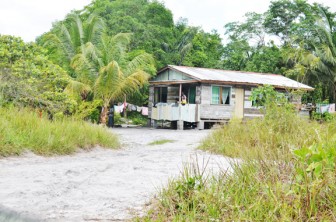Photos by Anjuli Persaud
Overlooking the Soesdyke-Linden Highway is a village called Long Creek which is home to about 400 persons who maintain a simple lifestyle because of the hardships they face.
Located 24.5 km up the highway, one would not imagine such a large settlement existed behind the thick vegetation, but if you follow a small trail, you come upon the scattered homes. There’s a mixed population of Amerindians, Africans and Indians, and two churches in the community testify to the fact that most of the residents are of the Christian faith.
At the time of this newspaper’s visit, the sun was scorching hot and the wind was still. Many persons were relaxing in their homes or preparing for their afternoon nap.
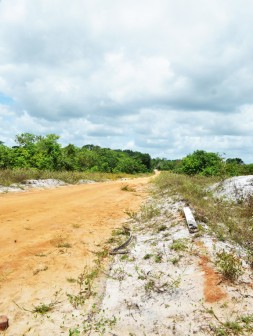
“It’s breezy, the fresh air and no noise. It’s quiet here. In Georgetown you can’t be sleeping right now [midday],” 22-year-old Amelia Gill said as she sat on her small verandah while small children inside lay down to rest on a mattress placed on the floor.
During a brief conversation with Stabroek News, Gill said her mother, who is originally from the North West District, moved to Long Creek 24 years ago and began life there. She noted that at that time, a large number of persons had already settled there. She was born and raised in the village, Gill said, but moved back and forth to different areas, including the city, but she always returned home and intends to start a family here. She stated that the only difficulty experienced in the village is the lack of electricity, which she considered the key factor that had made Long Creek stagnate.
“I think if we got electricity a lot more people would come and settle here because you find people reserving land, but not building anything on the land. That would help develop the place more,” she said. The young woman explained that persons who can afford to run a personal generator would do so, but this method is quite expensive, and many families had no electricity.
Gill recalled about 15 years ago when she was little, there was a power supply in the village, but wires and other parts were stolen that were never replaced.
She stated that while some people might complain about not having running water, she considers the issue of electricity much more critical, and said that the government and other relevant authorities should look into the matter. “We still don’t have running water either, but we can live without this; you can get a tank and catch the rainwater or go to the creek, but is the electricity we need,” she reiterated.
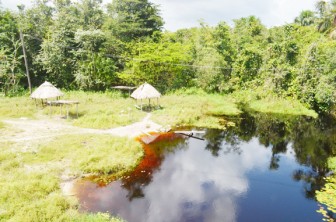
Another resident, Desiree Norville, who runs a small business out of the front of her home, said the electricity problem has ridiculous effects on persons, and that the only health centre for miles, the Cottage Health Centre, is also without power.
“I get all my children at the health centre. They don’t have doctors all the time but they have midwives. Many times they have to use lanterns because they don’t have lights,” she said.
“The only thing we want is lights,” Gill repeated and went on to say that though they have been faced with loam roads for decades, this does not bother residents since most of them do not have vehicles: “We don’t have a problem with the road because this is not a busy place; it’s only the lights we need.”
Both women agreed that there is no problem with crime at Long Creek, although occasionally, petty thieves may lurk. “You aint gotta study thief man or nothing; you can leave you door open and don’t worry about nobody coming and take anything,” Norville said.
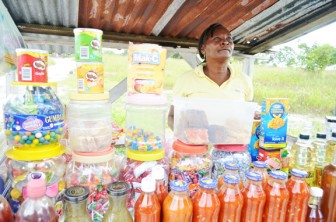
cold beverages and homemade pepper sauce and achar.
In this part of Guyana, the women are often the sole providers for their families which may consist of several children. These mothers would work long hours in the field, planting crops such as eddoes, cassava, sweet potatoes, bananas and other fruits or else would engage in fishing, which they view as recreational as well. It is common for them to sell their produce and catches along the highway to passing vehicles.
Also sold in the same way is coal, which may be considered the most popular business in Long Creek. As you drive along the Linden-Soesdyke Highway, you may come across piles of white bags. In these is the coal which many of the residents this newspaper encountered, said they are involved in producing. Also sold are wood pieces which are cut by female villagers.
“People is drink their life out up here. The men don’t really have places to go and sit down and drink, but you would find them going to the lil shops and buying their alcohol and drinking at home. When they drink, they does fight up among themselves, then make up the next day,” Gill said. Another resident, who refused to be named, agreed with this observation, noting “this is the hobby of the men. They love to drink.”
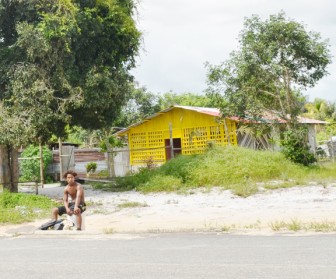
There are not many shops in the village and the few there are only offer limited items for sale, like sweets and soft drinks. As a result, residents say they are required to travel to Georgetown or Linden for major shopping purposes.
As a result, residents say they are required to travel to Georgetown or Linden for major shopping purposes.
Although there is one primary school in Long Creek and others in nearby villages, persons said that many of the children do not attend school even at this level, and more than likely, those who do would not pursue a secondary education. It was noted that there are no secondary schools in Long Creek or the neighbouring villages. Gill said that she was uncertain if children were not sent to school because of the financial difficulties experienced by most parents living there. Once old enough, she said, the kids move to the capital to seek a better livelihood.
“This is a good place to raise children but once they get big, they want to move away because they don’t have jobs to offer them here,” Norville added.

It was explained that a resort can be found some two miles down from the highway and it was said to be owned by Banks DIH, however, locals are not allowed there. Instead, persons enjoy a cool afternoon swim in the village creek which can be found below a Soesdyke-Highway bridge upon entering the settlement. Children and men alike most days take pleasure in a good old game of cricket as well.
One resident, who preferred to remain anonymous, said he had moved from Georgetown to Long Creek about seven years ago due to the increasingly high crime rate in the city. “In Georgetown, thing hot, hot. You can’t walk comfortable without somebody troubling yuh or doing yuh something,” he said.
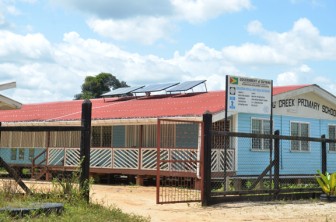
this photo.

